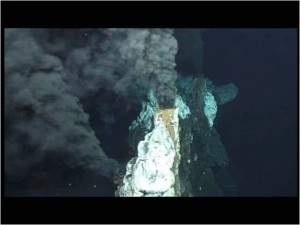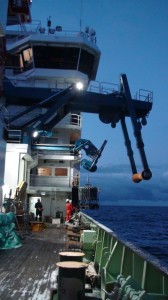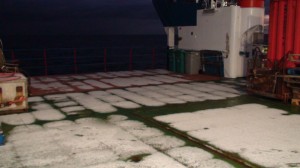“Are we nearly there yet?” “Not yet”
“Are we nearly there yet?” “Just a wee bit longer”
“Are we nearly there yet?” “Please stop asking”
“Are we nearly there yet?” “Yes we’re here”
But where exactly? That is a little harder to tell. We have arrived at a dot on an electronic map, but otherwise there is no outwardly visible feature to mark the end of our 8 day epic …the horizon looks the same in every direction and that is not just because it is black out there at night. Strangely, although we have arrived it is still 2½ km to our destination, just instead for heading N, S, E or W we need to look down. Time to park up and travel the rest of the way remotely.
So here we are parked…yes you can park a ship in the middle of the ocean. It is called dynamic positioning and broadly speaking it is an auto park function for the ship that will use global positioning satellites (that form the basis of your car sat nav systems) and the ships thrusters to hold the vessel on a point within a few metres. The thrusters are strong enough to move the ship 6knots sideways, which is very fast going considering our journey here was only at 12knots during the day and 6knots at night (high speeds, low visibility and iceberg ridden seas don’t mix).
We are now going to spend the next 4/5 days or so on station. I would be surprised if we move more than a 1km unless we go scouting around for new sites. Surprisingly sitting on station makes very little difference to life….the boat still rocks, the horizon is still “water water everywhere” and there is no sensation of being still. Weather will still make you walk in curves and S shapes down the corridor, crash into door frames as they reposition around you and generally make climbing stairs an entertaining experience where your knees buckle as the vessel rises to met you or make you feel all floaty as it drops away.
But we are here and the first task to see if the journey is worthwhile. The reason is that hydrothermal vents form when sea water percolates into the earth’s crust. In areas like where we are, magma is not that far from the surface. Magma at close to 1200oC heats the seawater in the crust and a combination of the heat and the extreme pressure experienced at this depth does some really funny things to it. It becomes a super critical fluid. It is neither liquid nor gas but something in between. Without these special conditions of temperature and pressure it cannot exist. This creates a comic book hero of our humble water imbuing it with special powers including for example the ability to dissolve metals.
Still bound by the rules of physics this super hot water >400oC rises buoyant towards the surface stripping chemicals out of the seabed as it goes. As this water exits the sea floor it is now carrying a load of metals and other minerals and chemical compounds and is still around 400oC and more acidic than vinegar. The hot water hits the cold and suddenly its ability to hold all these chemicals in solution is reduced. Cold is the vent fluids kryptonite. These chemicals precipitate (form into particles) out of the water building mineral chimneys around the edges and smoke plumes out the top.
[You can do a similar experiment yourself. Heat a glass of water add salt until it just stops dissolving. As the water cools you will see more and more salt in the glass as its ability to hold the salt in solution is reduced with its temperature…it won’t build chimneys though so don’t expect too much]
The problem is that the magmatic activity that generates the heat and gives the water it’s super powers is transient. Pathways to the surface block or change and the heating waxes and wanes. Thus vent sites have a life span and it is usually in the regional of a few decades. Our previous research suggests that the E2 vent side is dying. First task at this station is to drop the CTD over the side as see whether we still observe the smoke plume.

Sensor readouts...all the wiggly lines show how the chemical characteristics of the water change with depthProfile of the Starboard rail and the CTD headed to sniff out our vent plume. Is the site still active?
So was the journey worthwhile? You’ll know when I do. Not to worry much because as one vent site dies, another generally appears…we just have to find it.



